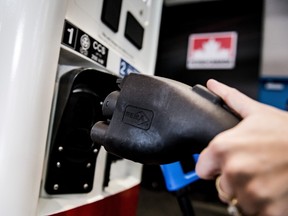Right now, roughly one-in-10 new cars driving off the lot are electric or plug-in hybrid. By 2035, the government has declared that number needs to be … all of them.
As far as goals go, you can’t fault the ambition, but is it even feasible?
Zero-emission vehicle sales will have to double within three years to hit the government’s first sales target

Right now, roughly one-in-10 new cars driving off the lot are electric or plug-in hybrid. By 2035, the government has declared that number needs to be … all of them.
As far as goals go, you can’t fault the ambition, but is it even feasible?
It depends on who you ask, but skeptics abound in both the automotive and energy sectors.
Automakers that don’t hit that target can offset new financial penalties by buying “credits” from other automakers or by building EV chargers (each $20,000 tranche of investment will be worth one credit).
Here are some of the questions Ottawa is face in its challenge to meet the target.
So does that mean 100 per cent of vehicles on Canadian roads will be zero-emission by 2035?
No. By the government’s estimate, it will take another 15 years for the last of gas-powered cars— or what it now calls “polluting light-duty vehicles” — to get off Canadian roads. The mandate only applies to new vehicles sold in Canada.
How many electric vehicles are actually sold in Canada yearly?
According to Statistics Canada data, only 10 per cent of new vehicle registrations across the country (132,783 total) were for electric vehicles or hybrids in the first nine months of 2023. But the average is pulled up significantly by British Columbia and Quebec, where heavy provincial rebates or tax incentives push their provincial averages up above 20 per cent.
Will there even be enough zero-emission cars by 2035 to be able to meet that demand?
Few observers appear to doubt the availability of enough zero-emission vehicles by 2035, but Automotive Parts Manufacturers’ Association President Flavio Volpe said the “overly aggressive” rules by Ottawa can “only” be met by importing vehicle from foreign manufacturers like Tesla and Vietnam’s VinFast.
But then again, most cars bought by Canadians currently aren’t even made in Canada, argues Electric Mobility Canada President and CEO Daniel Breton.
He also says zero-emission vehicle makers abroad have historically prioritized shipping to markets that set aggressive minimum EV sales, so Tuesday’s announcement should help bring in more vehicles to Canada.
Where things could get hairy is if more countries bring in similar mandates and the world’s automakers have to scramble to fulfill a huge amount of orders in multiple countries in a relatively short amount of time.
Even with the current government rebates in place, gas-powered vehicles are indeed cheaper than EVs by an average of $14,000 each, according to Canadian Vehicle Manufacturers’ Association President Brian Kingston.
Environment Minister Steven Guilbeault said he believes that will change by early in the next decade as production increases, more car manufacturers get involved and the technology evolves and improves. But only time will tell.
What about electricity? Will we have enough of it — and specifically, renewable-powered electricity, as required by the federal government — to charge all these vehicles?
The federal government’s acknowledges in Budget 2023 that growing needs for electricity, namely from zero-emission vehicles and transitioning towards low-carbon emission energy projects, will require the country to “supercharge” its electricity production by 2050.
Because the government has set a 2035 deadline to achieve a net-zero electricity system, multiple studies have found that Canada will have to double or triple its generation capacity by 2050. Even proponents of these mandates see this as the biggest challenge Canada will face. A report last year from the Canadian Climate Institute warned that “significant policy gaps still remain” and governments will have to be ready to “mitigate” rising prices.
It’s not just the capacity that matters. Researchers are worried about new peaks in the electrical system as Canadians all plug their cars in to charge at the same time. FortisAlberta has even offered customers who own an EV a $250 rebate to allow the company to study their car’s charging data.
“If you have a million electric cars and they all start charging at the same time, it will create a lot of problems for the network and perhaps cause a blackout,” said Claude El-Bayeh, a Concordia researcher in a paper that studied charging infrastructure.
Not at the rate we’re building them, according to a 2022 study commissioned by Natural Resources Canada, which found that there will need to be at least 442,000 public charging ports by 2035 to sustain the government’s goals. That’s on top of home charging access or shared private ports in multi-unit dwellings.
“We see a need for a significant acceleration in charging infrastructure deployment over the next five to ten years in order to support the federal government’s target of achieving 100 percent EV market share of new light-duty vehicle sales by 2035,” the authors wrote.
That concern was shared by Canadian Vehicle Manufacturers’ Association president Brian Kingston on Dec. 17, who called on the government to invest more in charging infrastructure instead of compelling Canadians to buy a specific type of vehicle.
But Breton says that charging technology is improving at a rapid rate and that batteries that took over one hour to charge years ago can now be almost fully replenished in 30 minutes. When combined with expanding battery ranges, the need for constant charging will drop, he predicts.
What is the Opposition saying?
If Liberal poll numbers stay low, it may all be academic anyway. Conservative Leader Pierre Poilievre didn’t directly say he would repeal the mandate, but he did say that the government’s ban on gas cars by 2035 is “extreme and radical” and amounted to a “car tax.”
“There’s a very serious risk that this will mean massive new costs for consumers,” said Poilievre, in an interview this week with the Toronto Sun’s Brian Lilley.
Poilievre said his preference is for “incentives and smart, light-touch regulations” that encourage energy efficiency in “each automobile that comes off the assembly line.”


TORONTO – Cineplex Inc. reported a loss in its latest quarter compared with a profit a year ago as it was hit by a fine for deceptive marketing practices imposed by the Competition Tribunal.
The movie theatre company says it lost $24.7 million or 39 cents per diluted share for the quarter ended Sept. 30 compared with a profit of $29.7 million or 40 cents per diluted share a year earlier.
The results in the most recent quarter included a $39.2-million provision related to the Competition Tribunal decision, which Cineplex is appealing.
The Competition Bureau accused the company of misleading theatregoers by not immediately presenting them with the full price of a movie ticket when they purchased seats online, a view the company has rejected.
Revenue for the quarter totalled $395.6 million, down from $414.5 million in the same quarter last year, while theatre attendance totalled 13.3 million for the quarter compared with nearly 15.7 million a year earlier.
Box office revenue per patron in the quarter climbed to $13.19 compared with $12 in the same quarter last year, while concession revenue per patron amounted to $9.85, up from $8.44 a year ago.
This report by The Canadian Press was first published Nov. 6, 2024.
Companies in this story: (TSX:CGX)
The Canadian Press. All rights reserved.

TORONTO – Restaurant Brands International Inc. reported net income of US$357 million for its third quarter, down from US$364 million in the same quarter last year.
The company, which keeps its books in U.S. dollars, says its profit amounted to 79 cents US per diluted share for the quarter ended Sept. 30 compared with 79 cents US per diluted share a year earlier.
Revenue for the parent company of Tim Hortons, Burger King, Popeyes and Firehouse Subs, totalled US$2.29 billion, up from US$1.84 billion in the same quarter last year.
Consolidated comparable sales were up 0.3 per cent.
On an adjusted basis, Restaurant Brands says it earned 93 cents US per diluted share in its latest quarter, up from an adjusted profit of 90 cents US per diluted share a year earlier.
The average analyst estimate had been for a profit of 95 cents US per share, according to LSEG Data & Analytics.
This report by The Canadian Press was first published Nov. 5, 2024.
Companies in this story: (TSX:QSR)
The Canadian Press. All rights reserved.

ST. JOHN’S, N.L. – Fortis Inc. reported a third-quarter profit of $420 million, up from $394 million in the same quarter last year.
The electric and gas utility says the profit amounted to 85 cents per share for the quarter ended Sept. 30, up from 81 cents per share a year earlier.
Fortis says the increase was driven by rate base growth across its utilities, and strong earnings in Arizona largely reflecting new customer rates at Tucson Electric Power.
Revenue in the quarter totalled $2.77 billion, up from $2.72 billion in the same quarter last year.
On an adjusted basis, Fortis says it earned 85 cents per share in its latest quarter, up from an adjusted profit of 84 cents per share in the third quarter of 2023.
The average analyst estimate had been for a profit of 82 cents per share, according to LSEG Data & Analytics.
This report by The Canadian Press was first published Nov. 5, 2024.
Companies in this story: (TSX:FTS)
The Canadian Press. All rights reserved.


Voters back Nebraska’s ban on abortions after 12 weeks of pregnancy and reject a competing measure


Justin Trudeau congratulates Donald Trump on his U.S. presidential win


Final day for candidate nominations in Nova Scotia election campaign


Greater Toronto home sales jump in October after Bank of Canada rate cuts: board


Trump’s victory sparks concerns over ripple effect on Canadian economy


Canadanewsmedia news November 06, 2024: Trump declares victory and secures comeback


Murder-suicide in Cole Harbour, N.S., was intimate partner violence, police say


Trudeau, Freeland embrace a second Trump presidency |